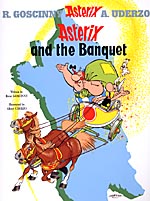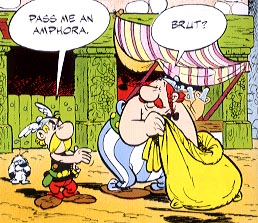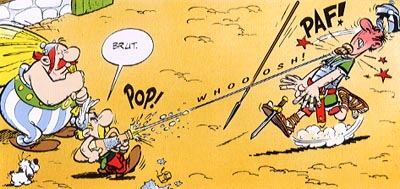 Written by Rene Goscinny
Written by Rene Goscinny
Art by Albert Uderzo
48 pages, color
Published by Orion Books
Way back in 1980, a friend from school invited me over to his house, one who promised to show me what he called the funniest books ever. His relatives from England sent them to him for his birthday ever year, a series of graphic albums starring the Gaulish warriors Asterix and Obelix. Over the next couple of weeks I read all of the Asterix books he had, and I’ve been a fan ever since then.
In the only Gaulish village yet to be conquered by the Roman Empire, trouble is brewing again. The Romans are building a blockade around the village, claiming that this village of rebels isn’t really part of Gaul at all. That’s when the bet comes in: Asterix and Obelix say that they’ll go where they want, and to prove it they’ll journey through all of Gaul and bring back specialty foods from each region and hold a massive banquet. If they can succeed, the Romans will stop building the blockade. The Romans, of course, plan on stopping Asterix and Obelix by any means necessary. Asterix, however, has packed a flagon of the village’s magic potion that gives the user super-strength…
 The fifth Asterix album published, Asterix and the Banquet has always been one of my favorites. In many ways it typifies the Asterix series, with a crazy scheme being hatched that will ultimately result in the foiling of the Romans. It’s always fun to read these books because Rene Goscinny had such a talent for writing the characters, something that shines through even as it’s translated from French into English. (Having read a handful of the original French-language editions in high school, it’s safe to say that these really are some of the best translations in comics in that they’re able to capture the spirit and humor of the originals.) Asterix’s “can-do” attitude and wits make him the perfect protagonist, while Obelix’s super-powered bull-in-a-china-shop and amiability make him a great sidekick as his simpler view of life often is the real solution to the problems they encounter. Asterix and the Banquet‘s story, bringing the duo through all of France, is fun because it lets Goscinny make jokes about all different areas of the country, while at the same time keeping the jokes accessible to people who don’t necessarily know what are really elaborate jokes about regions of France.
The fifth Asterix album published, Asterix and the Banquet has always been one of my favorites. In many ways it typifies the Asterix series, with a crazy scheme being hatched that will ultimately result in the foiling of the Romans. It’s always fun to read these books because Rene Goscinny had such a talent for writing the characters, something that shines through even as it’s translated from French into English. (Having read a handful of the original French-language editions in high school, it’s safe to say that these really are some of the best translations in comics in that they’re able to capture the spirit and humor of the originals.) Asterix’s “can-do” attitude and wits make him the perfect protagonist, while Obelix’s super-powered bull-in-a-china-shop and amiability make him a great sidekick as his simpler view of life often is the real solution to the problems they encounter. Asterix and the Banquet‘s story, bringing the duo through all of France, is fun because it lets Goscinny make jokes about all different areas of the country, while at the same time keeping the jokes accessible to people who don’t necessarily know what are really elaborate jokes about regions of France.
 In many ways, that sums up one of the things I’ve always liked about the Asterix graphic novels. As a 3rd grader, I found the books to be hysterically funny. Twenty-five years later, I still think they’re funny but now I understand even more of the jokes. Goscinny packs the Asterix books full of puns and humor that works on a number of levels. As a kid I understood the joke about Asterix felling a Roman legionnaire with the cork from a champagne bottle, and I even picked up on the whole brut (the wine) and brute (a mean individual) pun. Now that I’m reading it again, I’m catching things like the winekeeper’s red nose, or his comment, “Mumm’s the word” also being a reference to Mumm Champagne, or that the owner of the chariot that acts as a tow-truck being “Nervus Illnus”. It’s a wonderfully silly book, moving incredibly fast and lending itself to dozens of re-reads where little jokes packed into the corners of the pages are revealed and make you laugh all over again.
In many ways, that sums up one of the things I’ve always liked about the Asterix graphic novels. As a 3rd grader, I found the books to be hysterically funny. Twenty-five years later, I still think they’re funny but now I understand even more of the jokes. Goscinny packs the Asterix books full of puns and humor that works on a number of levels. As a kid I understood the joke about Asterix felling a Roman legionnaire with the cork from a champagne bottle, and I even picked up on the whole brut (the wine) and brute (a mean individual) pun. Now that I’m reading it again, I’m catching things like the winekeeper’s red nose, or his comment, “Mumm’s the word” also being a reference to Mumm Champagne, or that the owner of the chariot that acts as a tow-truck being “Nervus Illnus”. It’s a wonderfully silly book, moving incredibly fast and lending itself to dozens of re-reads where little jokes packed into the corners of the pages are revealed and make you laugh all over again.
 Albert Uderzo’s art has always been nice, even if it isn’t the selling point of the book. It’s a clean style that’s well suited to slapstick, crazy battles, and characters (usually Romans) having simmering rage: all essential to an Asterix book. Uderzo’s able to take all of Goscinny’s jokes and make them really come to life on the page, like the ink running off of the run-down horses from the used-chariot salesman, or Asterix’s firing a cork at a Roman soldier. The art is definitely in service to the writing and not the other way around, but that doesn’t make it bad. Uderzo’s a good artist, there’s just nothing particularly fascinating to notice. (And unfortunately, after Goscinny passed away, the albums both written and drawn by Uderzo proved once and for all which of the two was the greater talent.)
Albert Uderzo’s art has always been nice, even if it isn’t the selling point of the book. It’s a clean style that’s well suited to slapstick, crazy battles, and characters (usually Romans) having simmering rage: all essential to an Asterix book. Uderzo’s able to take all of Goscinny’s jokes and make them really come to life on the page, like the ink running off of the run-down horses from the used-chariot salesman, or Asterix’s firing a cork at a Roman soldier. The art is definitely in service to the writing and not the other way around, but that doesn’t make it bad. Uderzo’s a good artist, there’s just nothing particularly fascinating to notice. (And unfortunately, after Goscinny passed away, the albums both written and drawn by Uderzo proved once and for all which of the two was the greater talent.)
I’m utterly delighted that the rights situation for the original 24 Asterix albums by Goscinny and Uderzo are now resolved and that they’re all coming back into print. I’ve been buying my own copies of them and my neighbors must be getting slightly disturbed from the sound of me laughing myself silly every night. It doesn’t matter that I’d read these books probably twenty times over the past decade or two, courtesy my friend who had them all. They’re still some of the funniest books on the market, and once you read them you’ll understand why it’s such a big deal that they’re coming back into print in English. They’re even better than everyone says they are; they’re just that good.
Purchase Links:
